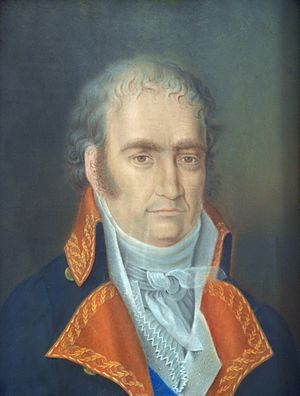Tomás de Morla y Pacheco facts for kids
Quick facts for kids
Tomás de Morla y Pacheco
|
|
|---|---|

Tomás de Morla y Pacheco
|
|
| Born | 1747 Jerez de la Frontera |
| Died | 1812 (aged 64–65) Madrid |
| Allegiance | |
| Service/ |
|
| Years of service | 1771 – 1808 |
| Rank | General |
| Commands held | Governor of Cadiz |
| Battles/wars | American Revolutionary War |
Tomás de Morla y Pacheco (1747–1812) was an important Spanish soldier and leader. He played a role in Spain's fight for freedom during a big war called the Peninsular War.
Contents
Tomás de Morla's Early Life
Tomás de Morla was born in Jerez de la Frontera, Spain, in 1747. His parents were Tomas Bruno Morla and Maria Lopez Pacheco de Saavedra y Valle.
Following his family's tradition, Tomás joined the military in 1764. He began his training at the Artillery Academy in Segovia.
Tomás de Morla's Military Career
Early Military Service
In 1780, Tomás de Morla was a lieutenant in the artillery. He took part in the American Revolutionary War, specifically during the Great Siege of Gibraltar. During this siege, he was wounded while fighting.
Later, in 1792, he served in the French Revolutionary Wars. He worked as a Quartermaster General in the Army of Rousillon. After this, he held various other important positions.
Becoming Governor of Cadiz
By 1800, Tomás de Morla was appointed as the governor of Cadiz. He also became the Captain General of Andalusia, a large region in southern Spain.
Actions During the Spanish Uprising
In 1808, the Spanish people rose up against the French. This event is known as the Dos de Mayo Uprising. Morla took action against a French navy group in Cadiz Bay. He successfully forced them to surrender in June.
The next month, he led forces from Cadiz in the Battle of Bailen. In this battle, the Spanish army defeated a French advance into Andalusia.
Negotiations and Later Life
However, after some later defeats, the Spanish government (called the Cortes Generales) felt that fighting more was pointless. Morla was sent to Madrid to try and negotiate a surrender. This attempt failed, and he became a prisoner of war to the French.
While he was held by the French, Morla decided to work for King Jose. King Jose was Joseph Bonaparte, Napoleon's brother, who was placed on the Spanish throne by the French. Morla later had disagreements with the French general Dupont and decided to leave public life. Meanwhile, the Spanish Cortes had declared him a traitor. They took away all his awards and positions. Tomás de Morla died in Madrid in 1812.
Tomás de Morla's Writings and Studies
Teaching and Publishing
From 1780 to 1792, Tomás de Morla taught at the Artillery Academy in Segovia. During this time, he also wrote and published several books. These books were about artillery, how to build strong defenses (fortification), and different military campaigns.
Tratado de Artillería
His most famous work was the Tratado de Artillería (Treatise on Artillery), published in 1784. This book was a complete guide to everything about artillery. It covered logistics (how to move and supply armies), tactics (how to use artillery in battle), and how to make and use gunpowder. It became the most important book on the subject at the time and was translated into many languages.
Awards and Honors
Tomás de Morla received several high honors during his career. He was given the Grand Cross of the Order of Charles III. He was also a knight of the Order of Santiago. Additionally, he held the ecomienda of Campo de Criptana in La Mancha. However, when he joined the French side, he lost all these honors and was called a traitor by the Spanish government.
Sources
- Enrique de la Vega Viguera La Singular Vida de Tomas de Morla y Pacheco Militar y Politico Jerezano (pdf) (Spanish)
See also
 In Spanish: Tomás de Morla y Pacheco para niños
In Spanish: Tomás de Morla y Pacheco para niños

